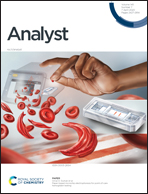Facile synthesis of fluorescent tungsten oxide quantum dots for telomerase detection based on the inner filter effect†
Abstract
The traditional detection of telomerase activity is mainly based on the polymerase chain reaction (PCR), which has the disadvantages of being time-consuming and susceptible to interferences; thus, here, we propose a facile method for the fabrication of fluorescent tungsten oxide quantum dots (WOx QDs) and employ them for telomerase activity sensing. It is found that the fluorescence of WOx QDs can be significantly quenched by hemin based on the inner filter effect (IFE). However, in the presence of telomerase, the primer-DNA can be extended to generate repeating units of TTAGGG to form G-quadruplex and thus, hemin can be encapsulated to reduce its absorbance, resulting in decreased IFE and efficient fluorescence recovery of WOx QDs. Based on the fluorescence changes of IFE between hemin and WOx QDs, the telomerase activity within the range of 50–30 000 HeLa cells can be detected and the lowest detection amount can reach 17 cells. The method exhibits good versatility that can also be applied to telomerase detection in A549 and L929 cells. In addition, because of the good biocompatibility of the sensor, it can be used for the real-time monitoring of telomerase activity in living cells, thus showing great potential in tumor diagnosis and inhibitor drug screening.



 Please wait while we load your content...
Please wait while we load your content...